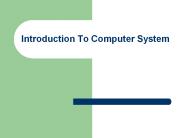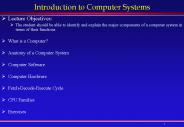Computer Software Application
1 / 22
Title:
Computer Software Application
Description:
Computer graphics and digital photos. Digital audio, digital video, and multimedia ... better maneuver your way through the basics of working with your digital images. ... – PowerPoint PPT presentation
Number of Views:45
Avg rating:3.0/5.0
Title: Computer Software Application
1
ComputerSoftware Application
2
- The computer's versatility is built upon its
- Hardware The physical part.
- Software The instructions that tells hardware
how to transform the input data (information in a
form it can read) into the necessary output.
Monitor
CD-ROM drive DVD drive
speakers
System unit
Keyboard
Mouse
3
- PC Software Basics
- Applications Computers in Action
- Application programs
- software tools that enable you to use a computer
for specific purposes. - Application programs also called simply
application. - Most PCs today use some version of the Microsoft
Windows operating system .
4
Application programs
- Word processing
- desktop publishing
- Spreadsheets and other number-crunching
applications - Databases
- Computer graphics and digital photos
- Digital audio, digital video, and multimedia
- Telecommunication and networking
- Artificial intelligence
- Entertainment
- General problem-solving
5
- Word Processing
- You can use a word processing program, such as
- Microsoft Word, to create memos, letters, term
papers, novels, textbooks, or Word Wide Web
page????? just about any kind of text-based
document. - In the PC world, a document is a file created by
an application.
6
- You can type and edit a word processing document
using standard PC techniques and tools. - Word processing program, contain text editing
tools for changing and rearranging the words on
the screen. - Most computer users are familiar with the
Clipboard, which can temporarily store chunks of
text and other data, making it possible to cut or
copy words from one part of a document and paste
them into another part of the same document or a
different document. - Text formatting commands enable you to control
the format of the document .for Example, you can
change the way the words will look on the page.
Most modern word processors include commands for
controlling the formats of individual characters
and paragraphs as well as complete document.
7
What is desktop publishing?
- The process of producing a book, magazine, or
other publication includes several steps - Writing text.
- Editing text.
- Producing drawing, photographs, and other
graphics to accompany the text. - Designing a basic format for the publication.
- Typesetting text.
- Arranging text and graphics on pages.
- Typesetting and printing pages.
- Binding pages into a finished publication.
- With Desktop-Publishing (DTP) technology, the
bulk of the production process can be
accomplished with tools that are small,
affordable, and easy to use.
8
Why Desktop Publishing?
- Desktop publishing offers several advantages for
businesses. - Desktop publishing saves money also saves time.
- Finally, desktop publishing can reduce the
quantity of publication errors.
8
9
What is The Spreadsheet ??
- The spreadsheet has changed the way people do
business. - Spreadsheet software enables the user to take
control of number, manipulating them in ways that
would be difficult or impossible otherwise. - A Spreadsheet program can make short work of
tasks that involve repetitive calculations
budgeting, investment management, business
projections, grade books, scientific simulations,
checkbooks, and so on. - A spreadsheet can also reveal hidden
relationships between numbers, taking much of the
guesswork of financial planning and speculation.
10
You can creating worksheet with Microsoft Excel
Microsoft Excel is a spreadsheet program that
lets you organize your data into lists and then
summarize, compare, and present your data
graphically. For example,you can have Excel find
the sum, average, or maximum value for sales on a
given day creat graph showing what percentage of
sales were in particular range and show how the
total sales compared with the total sales of
other days in the same week. In short, Excel
saves you from having to create these summaries
by hand.
11
PowerPoint
PowerPoint is a complete presentation graphics
package. It gives you everything you need to
produce a professional-looking presentation.
PowerPoint offers word processing, outlining,
drawing, graphing, and presentation management
tools- all designed to be easy to use and learn.
12
Network and Internet Basics
- PC Network Basics
- The internet is an elaborate network of
interconnected networks ?????a network that is
dramatically change the way people work, play,
and communicate. - Internet Basics
- A PC can be a window into the global system of
interconnected networks known as the internet, or
just the Net .
13
The Internet Revolution
- The Emergence of Networks
- Local-Area Networks (LANs)
- computers are physically close to each other,
usually in the same building, so they could share
resources, such as storage, printers. - Wide-Area Networks (WANs) extends over a long
distance. - a remote computer could connect to a network
through standard telephone lines by using a
modem, or using wireless connections. - a modem is an electronic device that could
translate computer data into signals compatible
with the telephone system.
14
The Internet Explosion
- Some examples about Internet Explosion
- Electronic mail
- E-mail software made it easy to send messages
across the office or around the world - World Wide Web
- Led the Internets transformation from a
text-only environment into a multimedia landscape
incorporating pictures, animation, sounds, and
video - people connect to the web each day through Web
browsers - Programs that, in effect, serve as navigable
windows into the Web
15
artificial intelligence
- The branch of computer science concerned with
making computers behave like humans. - Artificial intelligence includes
- games playing programming computers to play
games such as chess and checkers - expert systems programming computers to make
decisions in real-life situations (for example,
some expert systems help doctors diagnose
diseases based on symptoms) - natural language programming computers to
understand natural human languages - neural networks Systems that simulate
intelligence by attempting to reproduce the types
of physical connections that occur in animal
brains - robotics programming computers to see and hear
and react to other sensory stimuli
16
database management system
- A collection of programs that enables you to
store, modify, and extract information from a
database. There are many different types of
DBMSs, ranging from small systems that run on
personal computers to huge systems that run on
mainframes. The following are examples of
database applications - computerized library systems
- automated teller machines
- flight reservation systems
- computerized parts inventory systems
17
database
To access information from a database, you need
a database management system (DBMS). This is a
collection of programs that enables you to
enter, organize, and select data in a database.
(2) Increasingly, the term database is used
as shorthand for database management system.
- 1) Often abbreviated DB. A collection of
information organized in such a way that a
computer program can quickly select desired
pieces of data. You can think of a database as an
electronic filing system. - Traditional databases are organized by fields,
records, and files. A field is a single piece of
information a record is one complete set of
fields and a file is a collection of records.
For example, a telephone book is analogous to a
file. It contains a list of records, each of
which consists of three fields name, address,
and telephone number. - An alternative concept in database design is
known as Hypertext. In a Hypertext database, any
object, whether it be a piece of text, a picture,
or a film, can be linked to any other object.
Hypertext databases are particularly useful for
organizing large amounts of disparate
information, but they are not designed for
numerical analysis.
18
Graphics Software Terminology
- Graphics jargon can be confusing, especially for
those who are just learning how to edit digital
photographs or work with images for printing or
Web pages. - There are countless graphics software
packages available, each with its own options and
even different names for the basic functions you
can use to manipulate images (also called image
enhancement). - To help you better grasp graphics
software, we take a look at the genre and define
some the common terminology to help you better
maneuver your way through the basics of working
with your digital images.
19
some the common terminology
- Image Effects
- Many graphics programs come with predefined
algorithms that enable you to add special effects
to your images. The actual effects will depend on
the software you use. However, there are some
standard ones that you can expect to find in a
good program
20
some the common terminology
(continued)
2. Color DepthIn computer graphics, color depth
is how you describe the range of colors that can
be used in an image. The more colors used in an
image, the more realistic it will look 3.
EraserEraser tools allow you to erase areas
within your image to leave behind transparency or
a background color. There is also a Background
Eraser which provides more control in removing a
background to transparent
Original image (24-bit) showing zoom area
(Zoomed 200x185 crop) 256 colors (8 bit)
Background Eraser
Paint Tool
21
- To learn more about Microsoft Office visit
- www.office.microsoft.com
- And to learn more about software application
visit - www. webopedia.com
22
Reference































